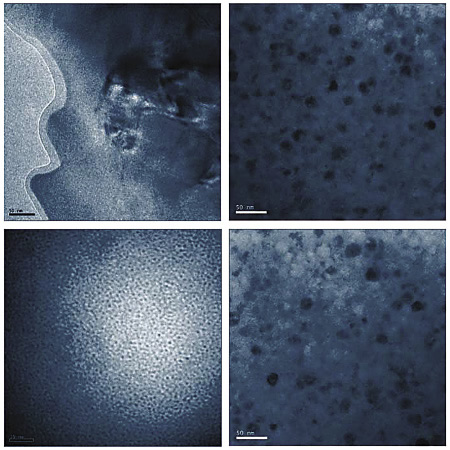A team of engineers from several California colleges has developed and tested a type of steel with a record-breaking ability to withstand impacts without permanent deformation. The new alloy, named SAM2X5-630, could be used in applications from drills to body armor to meteor-resistant casings for satellites. The material is an amorphous steel alloy, a subclass of steel alloys made of arrangements of atoms that deviate from steel’s classical crystal-like structure, where iron atoms occupy specific locations.


Transmission electron microscopy images show different levels of crystallinity embedded in the amorphous matrix of the SAM2X5-630 steel alloy. Image courtesy Jacobs School of Engineering, UC San Diego.

Researchers are increasingly looking to amorphous steel as a source of new materials that are affordable to manufacture and incredibly hard, yet resilient. SAM2X5-630 has the highest recorded elastic limit for any steel alloy, according to the researchers. The alloy can withstand pressure and stress of up to 12.5 gigapascals, or about 125,000 atmospheres, without suffering permanent deformation.
The researchers, from the University of California, San Diego, the University of Southern California and the California Institute of Technology, described the material’s fabrication and testing in a recent issue of Nature Scientific Reports.
“Because these materials are designed to withstand extreme conditions, you can process them under extreme conditions successfully,” said Olivia Graeve, a professor of mechanical engineering at the Jacobs School of Engineering at UC San Diego, who led the design and fabrication effort. Veronica Eliasson, an assistant professor at USC, led the testing efforts.
To make the solid materials that comprise the alloy, Graeve and her team mixed metal powders in a graphite mold. The powders were then pressurized at 100 megapascals, or 1,000 atmospheres, and exposed to a current of 10,000 amperes at 1,165° F (630° C) during a process called spark plasma sintering.
The process created small crystalline regions only a few nanometers across, with hints of structure, which researchers believe are key to the material’s ability to withstand stress. This shows that the properties of these types of metallic glasses can be fine-tuned to overcome shortcomings such as brittleness, which have prevented them from becoming commercially applicable on a large scale, Eliasson said.
Researchers at USC tested how the alloy responds to shock without undergoing permanent deformation by hitting samples with copper plates fired from a gas gun at 500 to 1,300 m/sec. (1,640 to 4,265 ft./sec.). The material did deform on impact—but not permanently.
The full study, “Shock Wave Response of Iron-based In Situ Metallic Glass Matrix Composites,” can be found online at www.nature.com/articles/srep22568. For more information on the project, visit jacobsschool.ucsd.edu/news.
Related Glossary Terms
- alloys
alloys
Substances having metallic properties and being composed of two or more chemical elements of which at least one is a metal.
- amorphous
amorphous
Not having a crystal structure; noncrystalline.
- composites
composites
Materials composed of different elements, with one element normally embedded in another, held together by a compatible binder.
- elastic limit
elastic limit
Maximum stress that a material can sustain without deforming.
- sintering
sintering
Bonding of adjacent surfaces in a mass of particles by molecular or atomic attraction on heating at high temperatures below the melting temperature of any constituent in the material. Sintering strengthens and increases the density of a powder mass and recrystallizes powder metals.

